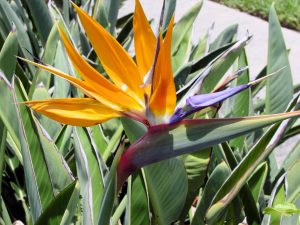
Many gardeners are familiar with the orange bird-of-paradise plant, Strelitzia reginae. This tropical herbaceous perennial is a common landscape plant in our area and is known for its stunning orange and blue complex flower that resembles certain tropical birds. Did you know that this South African plant was named to commemorate the British Queen, Charlotte of Mecklenburg-Strelitz? Our connection to Queen Charlotte and this plant is that in 1775, the British named the area that we now know as Charlotte County – “Charlotte Harbor” – after Queen Charlotte. Queen Charlotte had a great interest in botany, and as a result, the bird of paradise was named after her in 1778. And the rest – as they say – is history!
Available for sale at most garden centers, the orange bird of paradise shows up in almost every landscape at one time or another. One note up front is that the bird of paradise does better – in relation to flower production and general growth – in California and Hawaii – than in Florida. However, this should not discourage you from growing this plant as it still produces enough truly spectacular, long-lasting flowers to warrant inclusion in your landscape. It is a slow-growing plant, so patience for the first set of flowers is required – new plants may take up to two-years to bloom.
Careful planting will ensure a better chance of flowering. Providing about six feet between plants, make sure to plant the “bird” at the same depth it was originally. Planting it too deep can cause delayed flowering. Watering is also very important after planting, as well as to promote a large crop of flowers during the blooming season. The bird‑of‑paradise likes a sunny to part shade planting site with a compost-enriched, well‑drained soil. Interestingly enough, bird‑of‑paradise planted in partial shade grow taller with larger flowers. Those grown in full sun are smaller with shorter flowers.
Beyond the thick, waxy leaves which grow up to four feet long and make an impact in the landscape all by themselves; the flowers are the real jewel! Bracts, or colorful modified leaves, make up most of the “flower” with green, red and/or purple canoe‑like structures up to eight inches long. Within each of these bracts are small flowers of yellow or orange with a bright blue tongue. These fantastic flowers last up to two weeks as a cut flower. A mature plant can produce up to three dozen flowers over the September to May blooming season. In addition to the normal orange and blue flowers, there are a couple of unique types to explore. One is a yellow and blue form called ‘Mandela’s Gold’. This cultivar is distinctly different with golden yellow spathes. Another species of bird-of-paradise – Strelitzia juncea – offers a very different unique look. This plant is called the leafless bird-of-paradise and features narrow reed-like foliage.
Propagation is possible using either divisions or seed. Small plants or divisions taken from larger clumps may only take two years to bloom from transplants. However, bird of paradise grown from seeds will take up to five years to produce flowers – patience is needed in either case. An application of blood meal or controlled-release fertilizer as per label directions will help build a healthy plant.
The bird-of-paradise plant is a must have for any landscape – it is also Florida-Friendly Landscaping™ approved! For more information on flowering plants suitable to grow in our area, or to ask a question, you can also call the Master Gardener Volunteer Helpdesk on Mondays, Wednesdays, and Fridays from 1 to 4 pm at 764-4340 for gardening help and insight into their role as an Extension volunteer. Ralph E. Mitchell is the Director/Horticulture Agent for UF/IFAS Extension – Charlotte County. He can be reached at 941-764-4344 or ralph.mitchell@charlottecountyfl.gov. Connect with us on social media. Like us on Facebook @CharlotteCountyExtension and follow us on Instagram @ifascharco.
Resources:
Brown, S. P. & Black, R. J. (2024) Bird-of-Paradise. The University of Florida Extension Service, IFAS.
Nassau County Blog (2017) Bird-of-Paradise. The University of Florida Extension Service, IFAS – Nassau County.
UF/IFAS Gardening Solutions (2024) Bird-of-Paradise. The University of Florida Extension Service, IFAS.
The Florida-Friendly Landscaping Guide to Plant Selection & Landscape Design (2022) The University of Florida Extension Services, IFAS.
Dave’s Garden (2021) Strelitzia, Bird of Paradise, Crane Flower ‘Mandela’s Gold. https://davesgarden.com/guides/pf/go/54553.
Chase, L. (2024) Orange Bird of Paradise. https://www.south-florida-plant-guide.com/orange-bird-of-paradise.html.
Moulton, M. (2024) 6 Bird of Paradise Varieties for Your Indoor and Outdoor Garden. Epic Gardening – https://www.epicgardening.com/bird-of-paradise-varieties/.
Wikipedia (2024) Strelitzia reginae. https://en.wikipedia.org/wiki/Strelitzia_reginae#:~:text=Joseph%20Banks%20described%20the%20species,of%20a%20colourful%20exotic%20bird.
Florida Memory – State Library and Archives of Florida (2024) Queen Charlotte of Great Britain, wife of King George III. https://www.floridamemory.com/items/show/1473
 1
1
